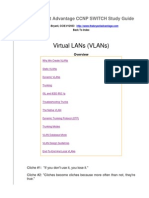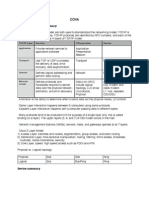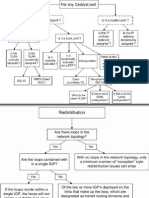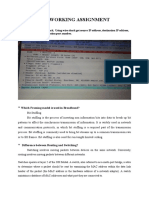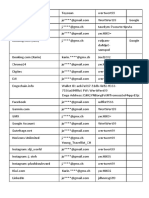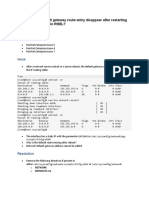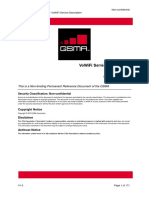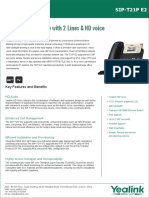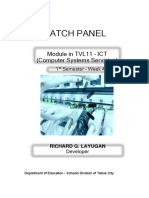Appendix D: Topics from Previous Editions 31
Example D-17 GLBP Status on R1 with show glbp brief
R1# show glbp brief
Interface Grp Fwd Pri State Address Active router Standby router
Gi0/0 1 - 110 Active 10.1.1.1 local 10.1.1.129
Gi0/0 1 1 - Listen 0007.b400.0101 10.1.1.129 -
Gi0/0 1 2 - Active 0007.b400.0102 local
Before looking at the right side of the output, first consider the context for a moment. This
example lists a heading line and three rows of data. These data rows are identified by the
Grp and Fwd headings, short for Group and Forwarder. With only one GLBP group config-
ured, R1 lists lines only for group 1. More important, each row defines details about a dif-
ferent part of what GLBP does, as follows:
Fwd is -: This line refers to none of the forwarders, and instead describes the AVG.
Fwd is 1: This line describes GLBP forwarder (router) 1.
Fwd is 2: This line describes GLBP forwarder (router) 2.
The output usually lists the line about the AVG first, as noted with a dash in the Forwarder
column. Now look at the highlighted portions on the right of Example D-17. This line will
list the virtual IP address and identify the active AVG and the standby AVG. This particular
command, from Router R1, lists R1 itself (“local”) as the active router. So, R1 is the current
AVG.
Each of the next two lines lists status information about one of the forwarder roles; that is,
a router that uses a virtual MAC address, receives frames sent to that address, and routes
the packets encapsulated in those frames. To that end, the Address column lists MAC
addresses, specifically the virtual MAC addresses used by GLBP, and not the interface
MAC addresses.
Each forwarder row also identifies the router that currently uses the listed virtual MAC in
the Active Router column. In Example D-17, 0007.b400.0101 is used by the router with
interface IP address 10.1.1.129 (which happens to be R2). 0007.b400.0102 is supported by
the local router (the router on which the show command was issued), which is R1.
The brief output of the show glbp brief command lists many details, but it takes some
effort to learn how to sift through it all. For more perspective on the output, Example D-18
lists this same show glbp brief command, this time on R2. Note that the Fwd column again
identifies the first line of output as being about the AVG, with the next two lines about the
D
two forwarders.
Example D-18 GLBP Status on R2 with show glbp brief
R2# show glbp brief
Interface Grp Fwd Pri State Address Active router Standby router
Gi0/0 1 - 100 Standby 10.1.1.1 10.1.1.9 local
Gi0/0 1 1 - Active 0007.b400.0101 local -
Gi0/0 1 2 - Listen 0007.b400.0102 10.1.1.9 -
The State column in the output in Examples D-17 and D-18 can pull the GLBP concepts
together. First, to define the meaning of the state values, the following short list defines
�32 CCNA 200-301 Official Cert Guide, Volume 2
the states expected for the first line of output, about the AVG, and then about each GLBP
forwarder:
AVG: One router should be the active AVG, with the other acting as standby, ready to
take over the AVG role if the AVG fails.
Each forwarder: One router should be active, while the other should be listening, ready
to take over that virtual MAC address if that forwarder fails.
Table D-4 collects the values of the State column from Examples D-17 and D-18 for easier
reference side by side. Note that, indeed, each line has either an active/standby pair (for the
AVG) or an active/listen pair (for the forwarder function).
Table D-4 Comparing Local State in show glbp brief Commands
Row Is About… Fwd Column Value R1 State R2 State
AVG - Active Standby
Forwarder 1 1 Listen Active
Forwarder 2 2 Active Listen
Finally, the show glbp command lists a more detailed view of the current GLBP status.
Example D-19 shows a sample from Router R1. Note that the first half of the output has
similar information compared to HSRP’s show standby command, plus it lists the IP and
MAC addresses of the routers in the GLBP group. Then, the end of the output lists a group
of messages per GLBP forwarder.
Example D-19 GLBP Status on R1 with show glbp
R1# show glbp
GigabitEthernet0/0 - Group 1
State is Active
2 state changes, last state change 00:20:59
Virtual IP address is 10.1.1.1
Hello time 3 sec, hold time 10 sec
Next hello sent in 2.112 secs
Redirect time 600 sec, forwarder timeout 14400 sec
Preemption disabled
Active is local
Standby is 10.1.1.129, priority 100 (expires in 8.256 sec)
Priority 110 (configured)
Weighting 100 (default 100), thresholds: lower 1, upper 100
Load balancing: round-robin
IP redundancy name is "GLBP-group-for-book"
Group members:
0200.0101.0101 (10.1.1.9) local
0200.0202.0202 (10.1.1.129)
There are 2 forwarders (1 active)
Forwarder 1
State is Listen
2 state changes, last state change 00:20:34
� Appendix D: Topics from Previous Editions 33
MAC address is 0007.b400.0101 (learnt)
Owner ID is 0200.0202.0202
Redirection enabled, 598.272 sec remaining (maximum 600 sec)
Time to live: 14398.272 sec (maximum 14400 sec)
Preemption enabled, min delay 30 sec
Active is 10.1.1.129 (primary), weighting 100 (expires in 8.352 sec)
Client selection count: 1
Forwarder 2
State is Active
1 state change, last state change 00:24:25
MAC address is 0007.b400.0102 (default)
Owner ID is 0200.0101.0101
Redirection enabled
Preemption enabled, min delay 30 sec
Active is local, weighting 100
Client selection count: 1
NOTE The content under the heading “Implementing Simple Network Management
Protocol” was most recently published for the 200-105 Exam in 2016, in Chapter 26 of the
Cisco CCNA ICND2 200-105 Official Cert Guide.
Implementing Simple Network Management Protocol
This section includes details of how to implement SNMPv2c and SNMPv3.
Implementing SNMP Version 2c
The exam topics mention SNMPv2c and SNMPv3 by name. As it turns out, SNMPv1 and
SNMPv2c configuration is very similar, because both use communities. SNMPv3 varies
quite a bit, mainly to implement the better SNMPv3 security features. This next section
shows how to configure and verify SNMPv2c.
Configuring SNMPv2c Support for Get and Set
SNMP configuration in Cisco IOS routers and switches works a little differently than many
other IOS features. First, the SNMP configuration exists in a series of global commands;
there is no SNMP agent configuration mode in which to collect subcommands. Secondly,
no single command enables the SNMP agent. Instead, IOS typically defaults for the SNMP D
agent to be disabled. Then, the first time an snmp-server global command is configured,
IOS enables the SNMP agent.
NOTE To disable the SNMP agent, you must remove all the snmp-server commands. You
can do this with a single no snmp-server command (with no parameters).
With that backdrop, a typical SNMPv2c configuration requires only one or two settings.
To be useful, the agent needs at least a read-only (RO) community string. The agent will not
reply to SNMPv2c Get messages without at least the RO community string configured. The
network engineer may also want the agent to have a read-write (RW) community string, to
support Set messages.



